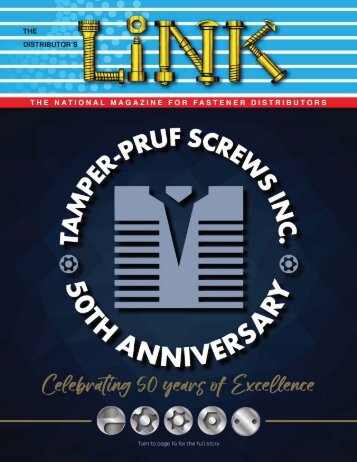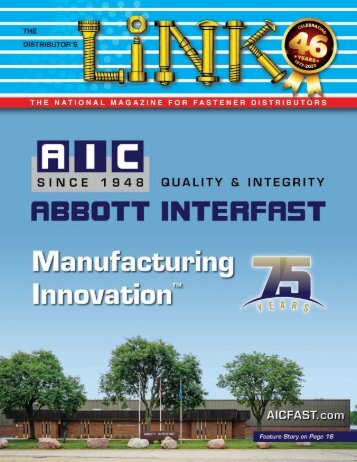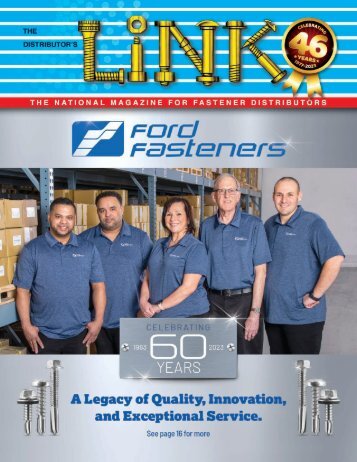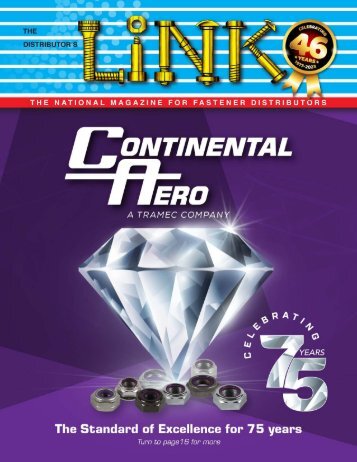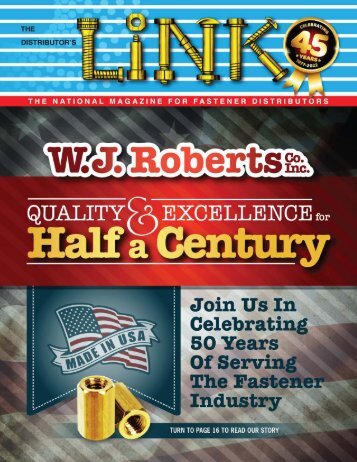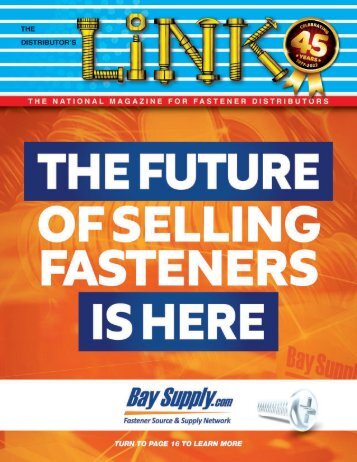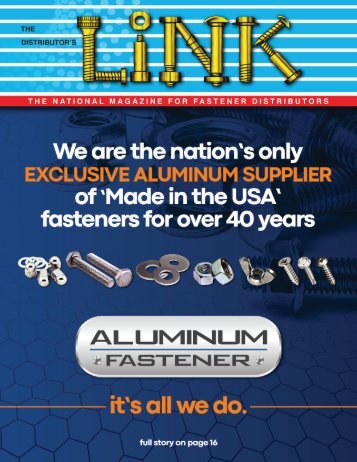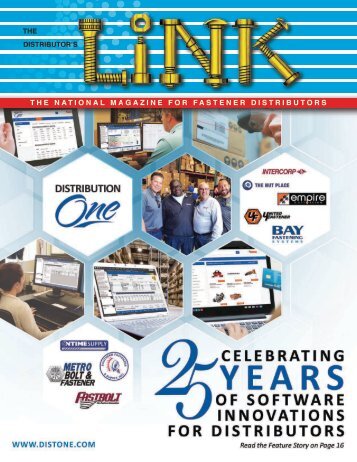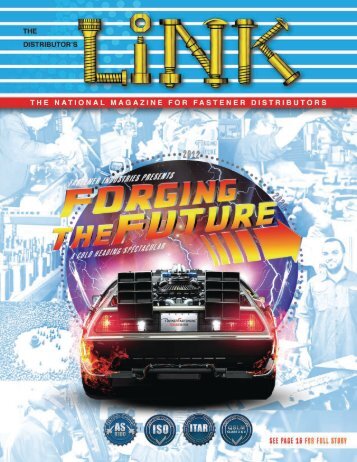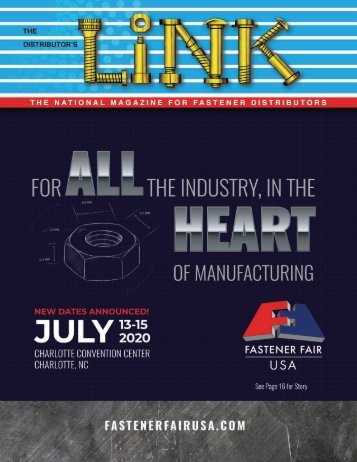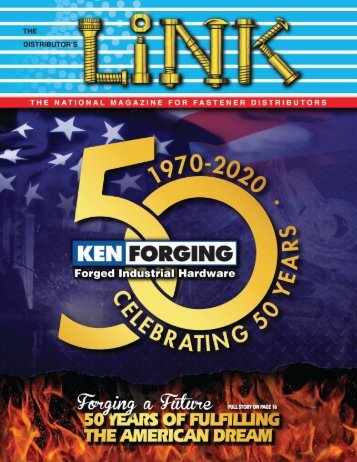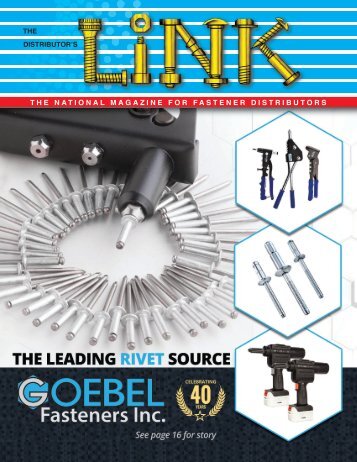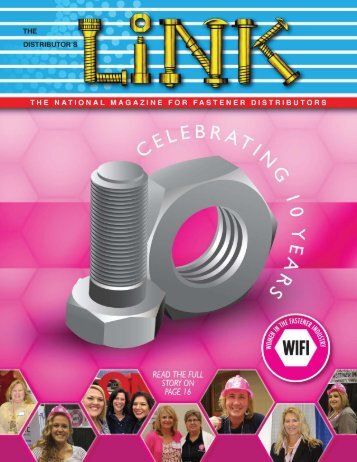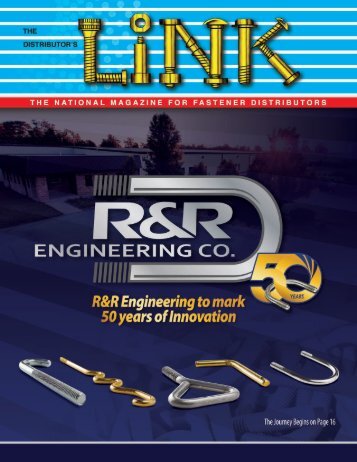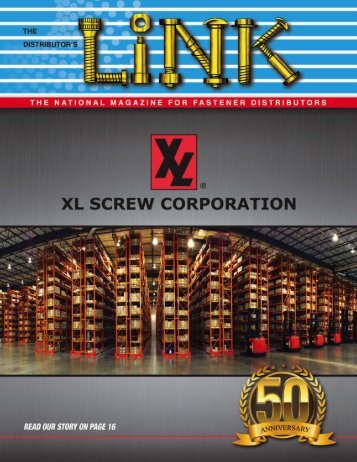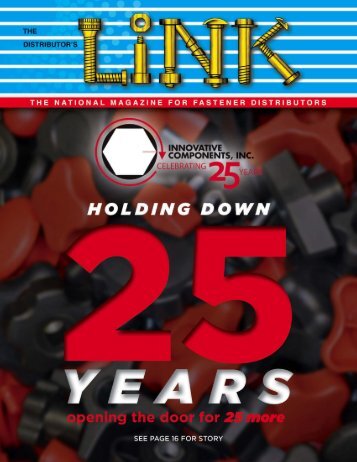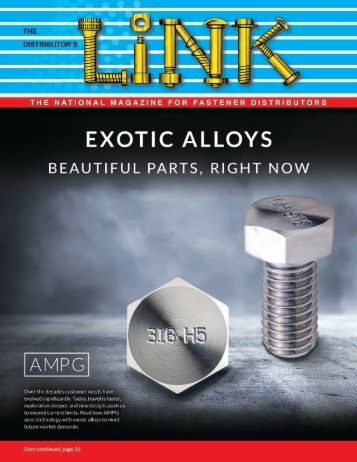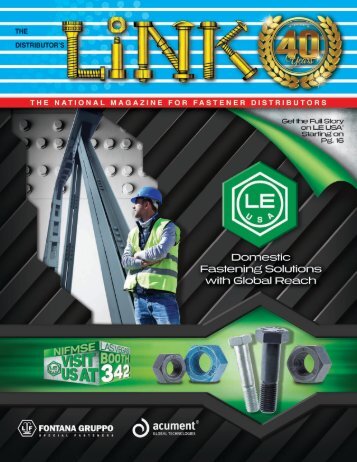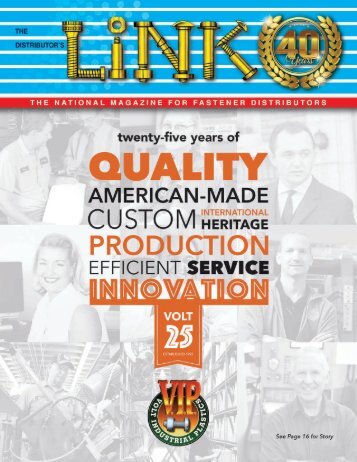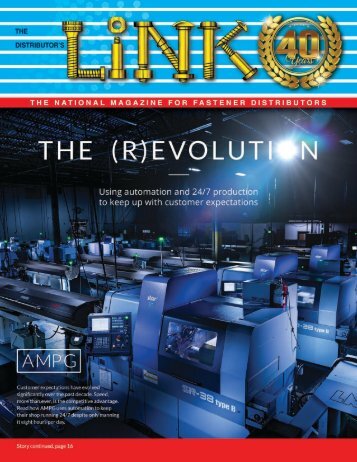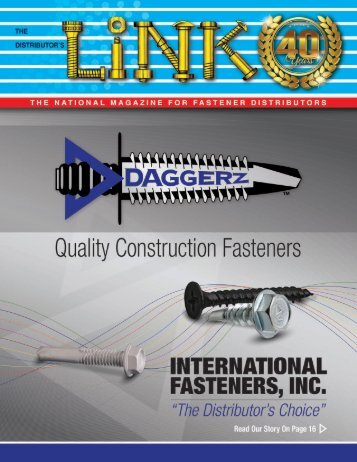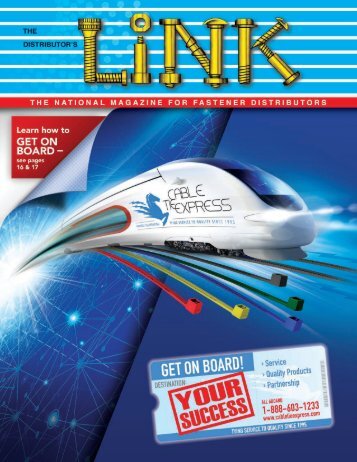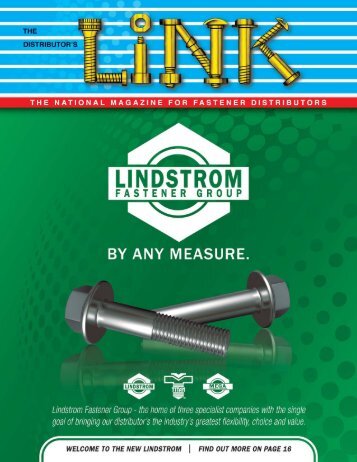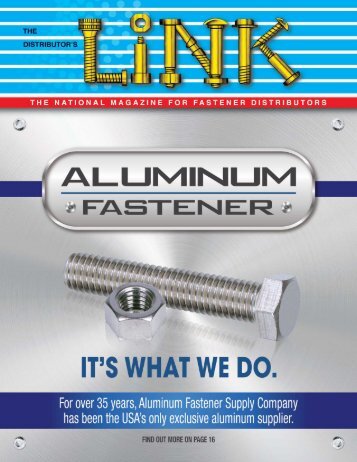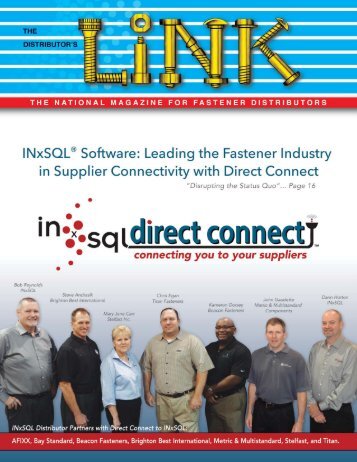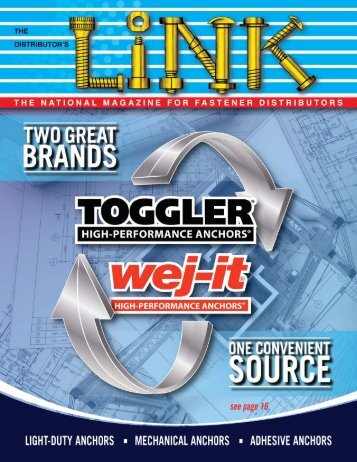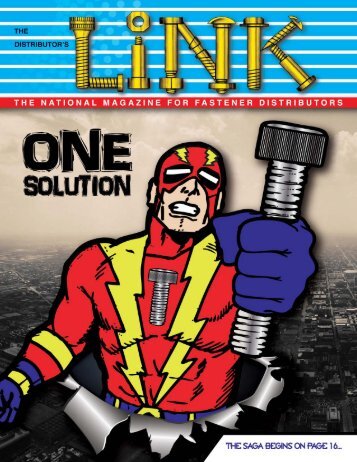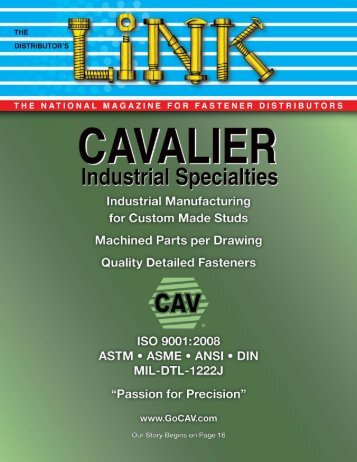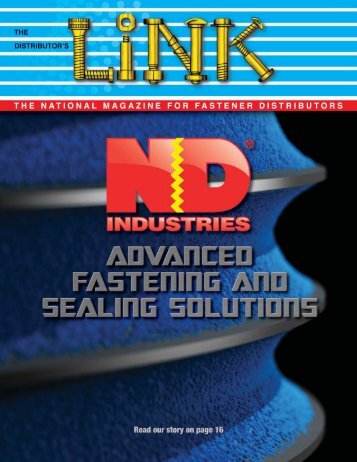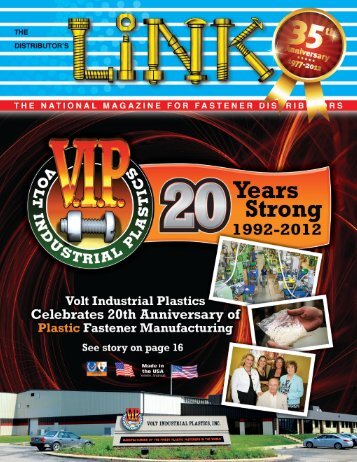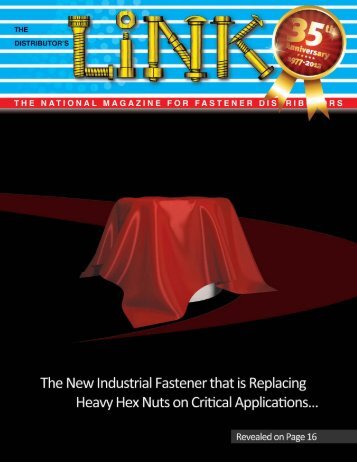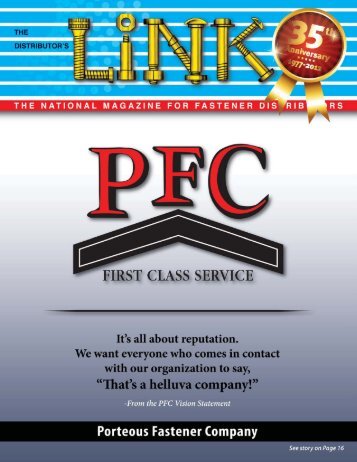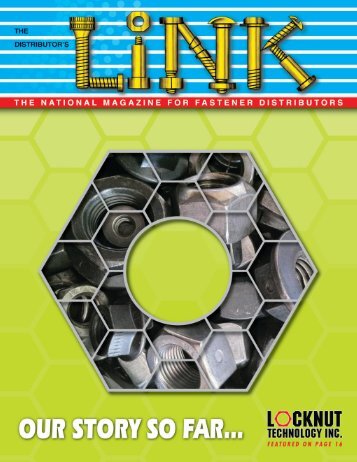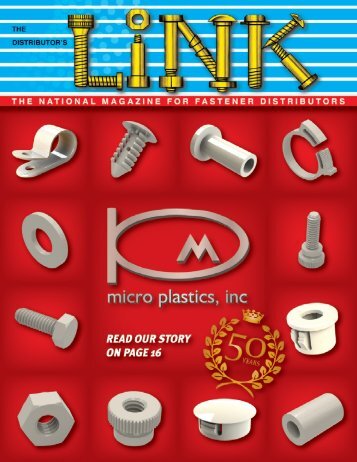WINTER 2019
- Text
- Fastener
- Fasteners
- Distributors
- Association
- Products
- Rivet
- Continued
- Industrial
- Screws
- Bolt
38 THE DISTRIBUTOR’S
38 THE DISTRIBUTOR’S LINK ROTOR CLIP COMPANY INC. 187 Davidson Avenue, Somerset, NJ 08873 TEL 1-800-557-6867 FAX 732-469-7898 EMAIL info@rotorclip.com WEB www.rotorclip.com RETAINING RINGS CURE FASTENER CONCERNS IN ANOTHER MEDICAL APPLICATION by Jürgen Wenzel, Global Marketing Manager Peristaltic pumps are used to move fluids along a tube in a variety of medical and industrial applications. They can pump sterile or harsh fluids without coming into contact with other components of the pump that can contaminate clean fluids or be damaged by acidic or viscous fluids. The core of the pump in this design is a series of rollers that are fastened to a wheel. A tube containing the fluid comes in contact with the rollers as they turn. The rollers pinch the tube in order to force the contents in the tube to move along. As the tube returns to its natural “un-pinched” state, between each roller, the force causes additional fluid to move through the passageway, thus keeping a steady flow through the pump. This is often referred to as a form of positive-displacement pumping. This process is called peristalsis and is used in many biological systems, most famously in the gastrointestinal THE EIGHT ROLLERS ARE HELD IN PLACE BY E RETAINING RINGS; AN E RING ALSO RETAINS THE ENTIRE WHEEL THE ROLLERS ARE ATTACHED TO. TECHNICAL ARTICLE ILLUSTRATION OF HOW A PERISTALTIC PUMP WORKS: THE ROLLERS ALTERNATELY DEPRESS THE TUBE AND ALLOW IT TO RETURN TO IT’S NATURAL STATE, CREATING A STEADY FLOW WITHOUT CONTACT WITH PUMP COMPONENTS. SOURCE: TETRAPAK tract. Common applications for peristaltic pumps include heart-lung machines to circulate blood during bypass surgery, and in hemodialysis systems. Designers were concerned about the extra costs associated with retaining eight seperate rollers on their own shaft using traditional fasteners, like screws, nuts and bolts. Limited space was also a consideration along with the costs associated with assembling so many small components. The E Retaining Ring was the fastener of choice, offering the designers the following advantages: ¤ Less shaft preparation (no threading, tapping or drilling) ¤ Reduced weight and size of finished designs ¤ Lower costs of raw material and labor in assembly of components. ROTOR CLIP COMPANY INC.
- Page 6 and 7: in theWinter 2019 issue of 8 HOW TO
- Page 8: 6 THE DISTRIBUTOR’S LINK Intercor
- Page 12: 10 THE DISTRIBUTOR’S LINK AIM TES
- Page 16: 14 THE DISTRIBUTOR’S LINK Laurenc
- Page 28: 26 THE DISTRIBUTOR’S LINK Joe Dys
- Page 32 and 33: 30 THE DISTRIBUTOR’S LINK Salim B
- Page 34: 32 THE DISTRIBUTOR’S LINK GLOBALF
- Page 38: 36 THE DISTRIBUTOR’S LINK PENN EN
- Page 44: 42 THE DISTRIBUTOR’S LINK BTM Man
- Page 47: THE DISTRIBUTOR’S LINK 45
- Page 52 and 53: 50 THE DISTRIBUTOR’S LINK SPECIAL
- Page 54 and 55: 52 THE DISTRIBUTOR’S LINK Robert
- Page 56: 54 THE DISTRIBUTOR’S LINK WOMEN I
- Page 59 and 60: THE DISTRIBUTOR’S LINK 57
- Page 61 and 62: THE DISTRIBUTOR’S LINK 59 MID-WES
- Page 63 and 64: INTERNATIONAL FASTENER EXPO - OPENI
- Page 66: 64 THE DISTRIBUTOR’S LINK Lindstr
- Page 69 and 70: Earnest Machine is now offering DIN
- Page 71 and 72: INTERNATIONAL FASTENER EXPO - OPENI
- Page 74: 72 THE DISTRIBUTOR’S LINK KINTER
- Page 78 and 79: 76 THE DISTRIBUTOR’S LINK KEY BEL
- Page 80 and 81: 78 THE DISTRIBUTOR’S LINK COMPUTE
- Page 82: 80 THE DISTRIBUTOR’S LINK SOUTHEA
- Page 85 and 86: THE DISTRIBUTOR’S LINK 83
- Page 88 and 89: 86 THE DISTRIBUTOR’S LINK EPICOR
- Page 90:
88 THE DISTRIBUTOR’S LINK J.W. Wi
- Page 94:
92 THE DISTRIBUTOR’S LINK The New
- Page 97 and 98:
THE DISTRIBUTOR’S LINK 95 AIM Tes
- Page 99 and 100:
THE DISTRIBUTOR’S LINK 97
- Page 101 and 102:
THE DISTRIBUTOR’S LINK 99 OBITUAR
- Page 104 and 105:
102 THE DISTRIBUTOR’S LINK AIM TE
- Page 106 and 107:
104 THE DISTRIBUTOR’S LINK GUY AV
- Page 108 and 109:
106 THE DISTRIBUTOR’S LINK LAUREN
- Page 110:
108 THE DISTRIBUTOR’S LINK FAB GR
- Page 113 and 114:
THE DISTRIBUTOR’S LINK 111 SOUTHW
- Page 115 and 116:
THE DISTRIBUTOR’S LINK 113 New PE
- Page 118 and 119:
116 THE DISTRIBUTOR’S LINK PENN E
- Page 120 and 121:
118 THE DISTRIBUTOR’S LINK ANTHON
- Page 122:
120 THE DISTRIBUTOR’S LINK JIM TR
- Page 125 and 126:
THE DISTRIBUTOR’S LINK 123 Field
- Page 127 and 128:
THE DISTRIBUTOR’S LINK 125
- Page 130 and 131:
128 THE DISTRIBUTOR’S LINK JO MOR
- Page 132 and 133:
130 THE DISTRIBUTOR’S LINK SPIROL
- Page 136 and 137:
fastenerlinks THE DEFINITIVE WEB DI
- Page 138 and 139:
fastenerlinks BRINGING YOU THE FAST
- Page 140:
fastenerlinks BRINGING YOU THE FAST
- Page 143 and 144:
INTERNATIONAL FASTENER EXPO MANDALA
- Page 146:
144 THE DISTRIBUTOR’S LINK BOLT B
- Page 149 and 150:
INTERNATIONAL FASTENER EXPO MANDALA
- Page 151 and 152:
THE DISTRIBUTOR’S LINK 149 COMPUT
- Page 154 and 155:
152 THE DISTRIBUTOR’S LINK BENGT
- Page 156 and 157:
154 THE DISTRIBUTOR’S LINK GUY AV
- Page 158 and 159:
156 THE DISTRIBUTOR’S LINK LAUREN
- Page 160:
158 THE DISTRIBUTOR’S LINK JOE DY
- Page 163 and 164:
THE DISTRIBUTOR’S LINK 161 CROSSW
- Page 165 and 166:
THE DISTRIBUTOR’S LINK 163 MID-WE
- Page 167 and 168:
THE DISTRIBUTOR’S LINK 165 ROBERT
- Page 169 and 170:
BRIGHTON-BEST INTERNATIONAL HALLOWE
- Page 172 and 173:
170 THE DISTRIBUTOR’S LINK BENGT
- Page 174 and 175:
172 THE DISTRIBUTOR’S LINK MWFA /
- Page 176 and 177:
174 THE DISTRIBUTOR’S LINK FASTEN
- Page 178 and 179:
176 THE DISTRIBUTOR’S LINK FASTEN
- Page 180 and 181:
178 THE DISTRIBUTOR’S LINK FASTEN
- Page 182 and 183:
180 THE DISTRIBUTOR’S LINK PUZZLE
- Page 184 and 185:
182 THE DISTRIBUTOR’S LINK MFDA 2
- Page 186:
INTERNATIONAL FASTENER EXPO MANDALA
- Page 190:
advertisers index D DARLING BOLT 75
- Page 194:
advertisers index R W.J. ROBERTS CO
Inappropriate
Loading...
Mail this publication
Loading...
Embed
Loading...
|
SHARE A PAGE FROM THIS MAGAZINE OPTION 1: Click on the share tab above, or OPTION 2: Click on the icon (far right of toolbar) and then click on the icon (far right of toolbar) and then click on the  icon (top right of the page). icon (top right of the page).
|
View Archives
Copyright © Distributor's Link, Inc. All Rights Reserved | Privacy Policy







